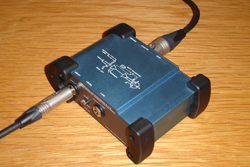
Active DIs need power, but can do more. With active circuitry, a designer has the option to do some tone shaping on the signal, or increase the gain before balancing the signal.
There are even some clever examples like the Radial JDX that not only captures the signal coming from the guitar head, but also the back electro-magnetic impulse from the loudspeaker. To pull that off, you need active circuitry.
We have a couple Avalon U5 active DIs that even require 120 volts to operate because they are a high voltage Class A design with all kinds of tone shaping possibilities. They sound fantastic and have a price tag to match.
Most active DIs will run from either batteries or phantom power, the later being the preferred choice. Almost all consoles now have phantom, and that provides a much more stable, reliable and powerful source of power for active DIs.
When To Use One Or The Other
Generally speaking, if the source is active like a keyboard, a passive DI will work great. Passive devices like bass guitars and some acoustic guitars will be better served with an active unit. A specialized pickup like a piezo-electric will need a specially designed, active DI to really maximize the sound.
But those are general rules of thumb. Ultimately, it comes down to matching the right tool for the job. If budgets are tight, passive DIs will work just fine. If you can afford a good active DI, like a Radial J48 for example, and it sounds good with your bass or acoustic, then use it.
My even more general rule of thumb is that an expensive DI will most often sound better than a cheap DI. Sure, you can find cheap ones under $25, and they will balance an unbalanced signal and give you output. But compared to something a little better (think $50-150), it won’t sound as good.
On the other hand, we use a lot of affordable yet very decent DIs (the Whirlwind IMP 2 is is about $40) in our student rooms, and they work just fine. For students playing relatively inexpensive instruments, I’m not sure it makes sense to spend $200 a channel.
However, on our main stage where we have professional and very serious amateur musicians with instruments that cost more than a good used car, I have no problem spending more. There, we use Radial ProD2s for keyboards, and Avalon U5s for bass and acoustic guitars.
Listening Tests
The best way to choose one over the other is to listen to them with your source and your PA. Sometimes, differences that show up in a studio just aren’t that apparent in a live sound setting.
If all goes well, in an upcoming post, we’re going to pull out some of our DI inventory and I’ll record some tracks and post them here. Stay tuned!
By the way, some of the information for this article came from the excellent FAQ section on the Radial website. Spend some time poking around there for more DI education.
Mike Sessler is the Technical Director at Coast Hills Community Church in Aliso Viejo, CA. He has been involved in live production for over 20 years and is the author of the blog, Church Tech Arts . He also hosts a weekly podcast called Church Tech Weekly on the TechArtsNetwork.
